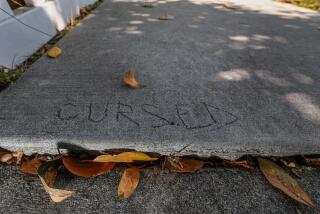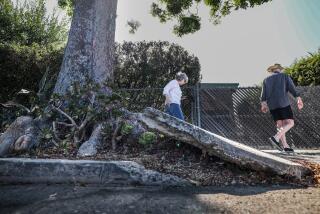Readers React: How an app destroyed their streets: Readers count the Waze
- Share via
For many drivers in Los Angeles, the app Waze is a godsend, providing real-time, crowdsourced traffic tips to motorists desperate for alternatives to congested thoroughfares and highways that, during rush hour, make a mockery of the word “freeway.” But to some residents of the formerly quiet neighborhoods through which Waze has rerouted countless commuters, the app has destroyed their quality of life.
Responding to Brian K. Roberts’ op-ed article Monday defending Waze against “traffic NIMBYs,” several readers described how their calm streets that connect to major traffic arteries -- but were previously known to do so only by those willing to study a Thomas Guide -- became busy commuting routes after the arrival of Waze. Roberts laments efforts by residents to bar access to public streets “maintained with my tax dollars,” whereas the readers say Waze has altered their lives so dramatically and without warning as to demand action by transportation planners
Like most traffic disputes, where people fall on this issue correlates strongly to perspective. Readers from the shaded, hilly areas of Sherman Oaks, Studio City and Echo Park -- which are all near major traffic corridors -- complain of their newly choked streets. A smaller handful of letter writers agrees with Roberts that all public streets ought to remain open to automobile traffic. The divide isn’t unlike the battle between cyclists and drivers, or between pedestrians and bike riders: Who we think getting around in Los Angeles ought to favor depends on whether we experience the streets from behind a windshield, on a bike saddle or on the sidewalk. For Waze, where we live adds another dimension.
It gets interesting where these interests overlap or even conflict. I’ll offer one case in point: me.
At a busy intersection near my house that connects middle-class Alhambra to San Marino, an old-money enclave that has the audacity to do things like charge non-residents for weekend access to its impressive Lacey park, signs are posted giving motorists the impression that driving straight through to Pasadena is forbidden; instead, drivers are told to take a circuitous route that deposits them away from most of the places considered worth visiting in Pasadena. Of course, those of us who live nearby disregard the signs and drive past the unwelcoming San Marino estates. A city’s wealth doesn’t give it the right to cut off access to public streets.
But I also live on an Alhambra block largely protected from speeding traffic that would otherwise spill over from a nearby six-lane boulevard. A barricade prevents most cars from accessing my street, forcing drivers to spend more time and gas traveling south. This added safety has tangible, quality-of-life benefits; it allows my young children and those of my neighbors to more freely play in our frontyards, and the lack of fast-moving, automotive throughput facilitates sociability among the residents.
Remove that barricade? Never. But San Marino shouldn’t even think about closing that direct route to Pasadena.
Hypocritical? Yes, but on this issue, hypocrisy isn’t in short supply -- which is why it’s up to government officials to consider all opinions, look at the big picture and make the hard decisions that are bound to be unpopular among many but serve the broader public interest.
And speaking of opinions, here is what some readers have to say about Waze and their neighborhoods.
Sherman Oaks resident Leon Sturman bemoans the “pretend freeway” his street has become:
Roberts is lucky to live on a cul-de-sac. I live on a narrow street that has access to Mulholland, Beverly Glen and Benedict Canyon.
Since Waze came along, the traffic in front of my house backs up to a continuous 20 vehicles between 7 a.m. and 9 a.m. waiting at a stop sign. The noise, the radios blaring, the fumes of vehicles idling cannot be healthy. I cannot back out of my driveway without great difficulty. I move my wife’s car to the street at 6 a.m. so she can get into the flow of traffic.
We had a peaceful residential home prior to Waze. Now we live on a pretend freeway.
Frances Terrell Lipman, also of Sherman Oaks, says traffic-choked neighborhoods are part of a larger problem:
Our small, Sherman Oaks neighborhood is subjected to Waze-induced problems on a daily basis.
The line of endless cars heading up to Mullholland Drive begins its assault round 7 a.m. and lasts until about 10 a.m. We are not able to leave our homes because drivers don’t often allow us out of your own driveways. Many drive right through stop signs with no regard for the laws in place.
This age-old Los Angeles problem of too many cars will never be solved until a realistic transit system is put in place. The 405 Freeway widening, which added a carpool lane, was a waste of money. When I watch the parade on my street each day, there is one person in every car, and no one seems willing to change the car mentality that has choked this city for 50 years.
Waze seems like a good idea for getting somewhere easily and without hassle, but many of us pay the price every day by having to breathe in more fumes and being stuck right in the thick of it. There must be a better way, if only the city would once and for all give it more thought and have better urban planning. Other major cities seem able to manage transportation; why can’t we?
Los Angeles resident Robert Fox says Waze creates challenges beyond congestion:
Roberts’ reasoning is specious at best.
The city doesn’t have the resources to make sure Roberts isn’t speeding through his neighborhood shortcuts. Logically speaking, people using shortcuts are likely to be in a hurry and people in a hurry are likely to be speeding. Moreover, people using mobile apps are likely to be juggling hand-held devices while people living on quiet streets are less likely to be vigilant in watching out for traffic.
This is a recipe for disaster.
Follow the Opinion section on Twitter @latimesopinion and Facebook
More to Read
A cure for the common opinion
Get thought-provoking perspectives with our weekly newsletter.
You may occasionally receive promotional content from the Los Angeles Times.











